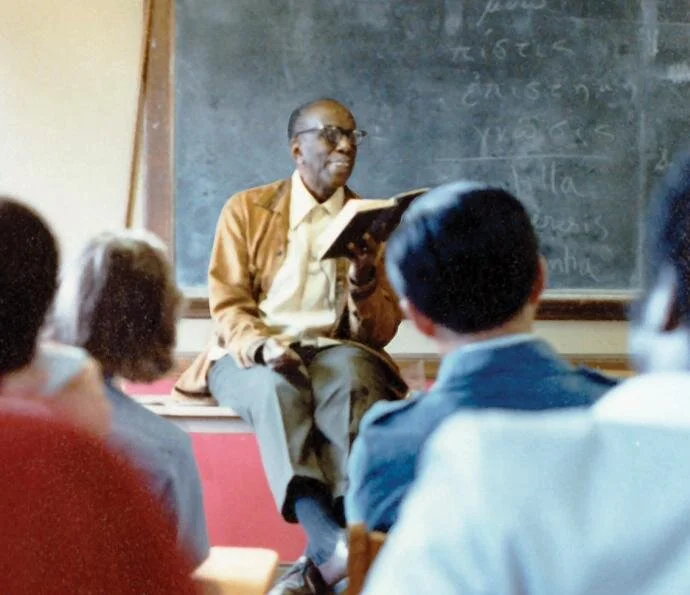St. Teresa de Avila, Part I: Engaging with the Divine, the Devil, and the Church
Bernini St. Teresa in Ecstasy, 1652, Cornaro Chapel, Sta Maria della Vittoria, Rome (a Discalced Carmelite church) (Photo: Livioandronico2013, CC BY-SA)
The mystic contemplatives who recently occupied us led me, when I glanced at the Episcopal Lectionary for October, to a jaw-dropping destination: Ávila, Spain, home of St. Teresa de Ávila (1515-1582; religious name Teresa de Jesús,). Teresa, who is honored by the Episcopal Church on October 15, is one of the greatest Christian mystics, Church reformers, and Church teachers of all time.
Teresa is also at the very root of the Catholic Counter Reformation that later celebrated St. Rosa de Lima whom we met earlier (Friday Reflection, September 4). Teresa was both one of the Counter Reformation’s most effective agents and the very embodiment of one of its most essential features: To reaffirm Christianity’s spiritual roots in primitive, ascetic seclusion, individual or communal, for spiritual cleansing and union with the divine. Though officially aimed at monasteries and convents in need of reform, that mission also targeted the lay community.
Teresa the mystic scared me, as a young Catholic girl in Latin America. Stories of her levitations and visions terrified me, for all my appetite for magic realism and miracles. The episodes frightened Teresa at first too.
Yet, with such encounters and a tumultuous life, she could experience joy and reach us all, centuries later, teaching us how to move inward in prayer and to open to joy in our own tumultuous lives.
For her lucidity and appeal to a changing world over centuries, in 1970 Teresa became one of the Church’s first two women Doctors [Teachers] of the Church with Catherine of Siena. Today, there are 4 Women Doctors, with Thérèse de Lisieux (1997) and Hildegarde von Bingen (2012). Teresa is the first (and so far only one among the Church Doctors) to be called a Doctor of Prayer.
She was also a busy, productive reformer and administrator in a complex world. As such she has much to teach us about negotiating an environment convulsed by divisiveness and suspicion with insight and even humor. She has much to say about engaging with our chosen community, so vulnerable to friction in its intimacy. Do these sound familiar?
Because we have so much to learn from her, we’ll explore aspects of Teresa’s life and work in three successive Reflections. Today, we’ll consider her world in general, and life up to the moment she took vows as a Carmelite nun in 1537. The second, to appear next Friday (October 16), will explore her life and experiences at the Monastery of the Incarnation in Avila. The third (October 23) will treat the extraordinary results of her final 20 years, the founding of a new order that returned to the Carmelites’ founding principles, and her evolved vision of inward prayer, the cornerstone of the contemplative life.
Teresa’s Life: Perils and Pathways
Teresa Sánchez de Cepeda y Ahumada was born in Avila, in the Kingdom of Castilla, in 1515, a remarkable time and place that shaped her approach to life.
At the heart of Teresa’s world was a phenomenon that ironically shapes ours as well: the unprecedented flood of information and its consequences. She was born at the beginning of a century that capitalized on the new printing press, invented in the early 15th century and quickly put to work. Books, prints, pamphlets, were suddenly accessible, in inexpensive editions, as never before. Such materials were also increasingly available in everyday language (French, Spanish, German) rather than the Latin of the highly educated. More people consequently gained access to information, to literature, whether they could read or were read to. They could also generate and distribute information by such means. That was how information about the religious Reformation in France and the Germanic countries spread throughout Europe.
In response, institutions escalated controls on information and new ideas. Governments and churches increased measures to manage, censor, and counter perceived or potential threat. In the Germanic countries from which the Wissahickon hermits fled (Friday Reflection, September 25), we saw repeated censorship and exiles.
An Iberia in Growing Pains
The Iberian peninsula, then a cluster of kingdoms that were isolated geographically, politically, culturally, and ethnically, was in an especially dynamic period during Teresa’s lifetime. Under the energetic rule of two monarchs who married and effectively ruled together, Isabel of Castilla y León and Fernando of Aragón, Iberian power had grown throughout the world with the fruits of their new empire in the Americas “discovered” in 1492. Domestically, the married monarchs unified their kingdoms, applying great effort to politically merge their diverse communities.
The primary means used: religion, the Catholic Church that was closely allied to the Crowns, notably through an institution established for the first time in Iberia, an Inquisition. The monarchy pushed for greater religious orthodoxy first by censoring publications that had exploded in quantity and distribution with the printing press. Censors were particularly hostile to religious texts in everyday language: The Gospels in Spanish (rather than Latin) were controlled as possible Lutheran propaganda. Such censorship deprived even educated Iberian women of primary sources since most women were not taught Latin. Mystical texts once considered acceptable were placed on a subsequent list of banned books (Indexes) by the Pope as well as Iberian Church authorities. Religious learning in Catholic domains, but especially Iberia, thus, was spotty, erratic. If you owned such books, they were imperiled: The Inquisition burned Teresa’s mystical texts in 1559, one of her many encounters with its agents and activities as her supernatural experiences were reported. She was careful, consequently, to submit her manuscripts to her Confessor for approval before allowing others to read them.
Through the Church, government also suppressed Iberia’s longstanding cultural and religious heterogeneity. Towards this latter end—also in 1492—they forced Jews to convert to Roman Catholicism under pain of expulsion. Soon after, when Isabel’s forces conquered the last Muslim stronghold, Granada, Muslims were given the same ultimatum. In both cases, many left. The Inquisition monitored Jews who did convert, called, among other things, conversos or marranos, for signs of continuing Jewish faith or worship. Church officials followed suspected Jewish holdouts as closely as individuals reportedly possessed by devils or heretics, ever a concern as different Christian doctrines and forms of spirituality emerged, raising constant debate and anxiety within the Church.
Teresa’s life and work, headquartered in Isabel’s domain, intimately and repeatedly engaged with these Church controls. The earliest, however, was the unrelenting suspicion of conversos. Her father Alonso was the son of a mixed marriage between an Old Christian (longstanding, pureblood Christian) woman and a Jewish convert in Toledo who, after being denounced, confessed to Judaizing (secretly continuing his Jewish practice). He then endured its humiliating punishment, repeated public processions wearing the Inquisition’s distinctive penitential robe, the sanbenito. When Juan’s textile business suffered with his denunciation, he christianized his name with his Christian wife’s, becoming Juan Sánchez de Cepeda, and moved the family to Ávila.
Panoramic view of Avila
Ávila, Teresa’s birthplace, remained her Place, her Center, throughout her life though she traveled extensively in her late years.This ancient walled city was an early Catholic community even under Muslim rule, and ever intensely devout, with many churches and monasteries. The expulsion of Jews and Muslims, however, deprived Ávila of its colorful heterogeneity and gradually weakened its energy as a thriving commercial city. Teresa’s grandfather nonetheless prospered commercially once again. He also bought a certificate of pure [Christian] blood to move into the lesser nobility, easing his acceptance by Catholic society.
Teresa was one of his son Alonso’s 10 children with his second wife, Beatriz Dávila de Ahumada y Cuevas, an Old Christian from Ávila—yet another means to legitimize the family in Iberian society. The family was close, with supportive and enduring bonds among siblings. Teresa, named after her maternal [Christian] grandmother, was especially devoted to her father, was even his acknowledged pet particularly after her mother’s death in 1528 when Teresa was 13. Yet, wanting a mother, Teresa dedicated herself to the Blessed Virgin Mary.
In her accounts of her spiritual development for Church authorities of the 1560s, Teresa insisted on the piety and Christian acts of both parents, emphasizing her mother’s adherence to her deep Christian heritage but also subtly addressing suspicions surrounding her father’s converso roots. Similarly, she stressed his brother’s huge influence on her spiritual development with gifts of Christian literature, The Letters of Jerome and the Third Spiritual Alphabet of 1527 by the Franciscan Francisco de Osuna.
Her only criticism of her parents (again for the Church of the 1560s) was her mother’s fondness for chivalric romances and her parents’ reluctant hospitality to vain, materialistic, silly relatives. Teresa claimed those two weaknesses led her astray, as a genuinely devout child prone to wickedness and worldly vanities. The underlying lesson: Parents should clear the household of temptations. Still further, her conclusion argued the need for cloistered communities to protect the devout (if as wicked as she was) from the corrupt world.
In stressing her own piety as a girl, Teresa told her Inquisitors about two adventures that demonstrate her leadership skills and wry humor. Wishing to achieve heaven’s delights with God immediately, she decided she wanted a quick and rewarding death like the martyrdoms described in the Lives of the Saints. As a child, she and a brother planned to go to the “land of the Moors and beg them, out of Love of God, to cut off our heads there.” ((Teresa de Ávila, The Book of Her Life, 1:4). They made it as far as the bridge over the Adaja River running along Ávila’s west side before an uncle caught them. Teresa’s account continues, “When I saw it was impossible to go where I would be killed for God, we made plans to be hermits” [Life, 1:5). Unfortunately, the stones used to build their hermitage kept falling down. Lesson: Nothing comes quickly or easily; earthly goals and the ultimate reward require preparation. She would apply that lesson to her approach to prayer.
That early oscillation between worldliness and piety continued through most of her life.
Fray Juan de la Miseria, Portrait of Teresa, the only known likeness taken from life
Her winning appearance and personality since childhood reinforced her worldliness.
She admitted to loving beautiful clothes (she was the darling of textile merchants, after all), finery, and a meticulous toilette that flattered her already appealing presence. According to biographers, even at age 61 when this portrait was painted, she was comely (even beautiful, for some), shapely (even plump), warmly vivacious, and contagiously cheerful even when ill. She made friends with genuine heart, enjoying a social network that grew and helped her throughout her life.
At 16 she entered boarding school at the Augustinian monastery of Our Lady of Grace (which still exists) but left early because of illness that left her with a weak heart, the first of many physical ailments. After much thought and discussion with relatives, she chose monastic life.
She later gave various reasons why: that she was inspired by her uncle’s gifted Letters of Jerome; that she feared hell. To Church authorities in the 1560s, she claimed she liked the one she chose (The Carmelite Monastery of the Incarnation), where she had a friend, thinking this is where “I thought I could serve God more or where my father desired,” that she felt it more important to remedy her soul than give herself any easy way of life (Life, 4:1). Her father instead balked, ordering her to take the veil only after his death. When she proved her resolve by running away in 1535 to enter the Incarnation, her father relented and generously supported her. She later told Church authorities that her embattled decision pleased God, who gave her a deep happiness at being in the “religious state of life” that never left her. She took the habit in 1536 and made her religious profession in 1537 under the name Teresa de Jesús.
Why the Incarnation, a Carmelite monastery? This is a quirky story with telling insights and huge new experiences for Teresa—including her celebrated levitations and visions—that we’ll pursue next Friday.
So stay tuned!
—Suzanne Glover Lindsay, St. Stephen’s historian and curator









